Mastering market predictions with the VIX involves interpreting key VIX levels, recognizing shifts in volatility, and incorporating VIX data into trading plans. Understanding VIX patterns, like spikes above 30 signaling market stress, aids in anticipating market movements. VIX's historical trends reveal insights into current market conditions. Utilizing the VIX as a market indicator enhances decision-making during volatile conditions. Leveraging VIX data assists in maneuvering market reversals and adjusting strategies accordingly. Embracing the VIX as a stock volatility indicator guide empowers investors to make well-informed decisions in dynamic market environments, ensuring a strategic approach to trading success.
Understanding the VIX Index
The VIX Index, established by the Chicago Board Options Exchange in 1993, serves as a real-time measure that reflects market sentiments regarding anticipated changes in the S&P 500 index. Commonly referred to as the 'fear gauge,' the VIX is calculated using at-the-money SPX options with near-term expiration dates. It is essential to understand that the VIX does not indicate current or historical levels of volatility but rather market expectations of future volatility.
When the VIX value rises, it typically suggests a potential decline in S&P 500 prices and an increase in SPX put options. This relationship signifies that investors are expecting higher volatility and are buying more put options for downside protection. Conversely, a decreasing VIX value indicates a more stable market environment with lower expected volatility.
In essence, mastering the VIX involves interpreting this index as a measure of market uncertainty and expectations for future S&P 500 movements. By understanding the VIX's dynamics and its relationship with market behavior, investors can gain insights into potential market trends and make more informed decisions.
Interpreting VIX Patterns
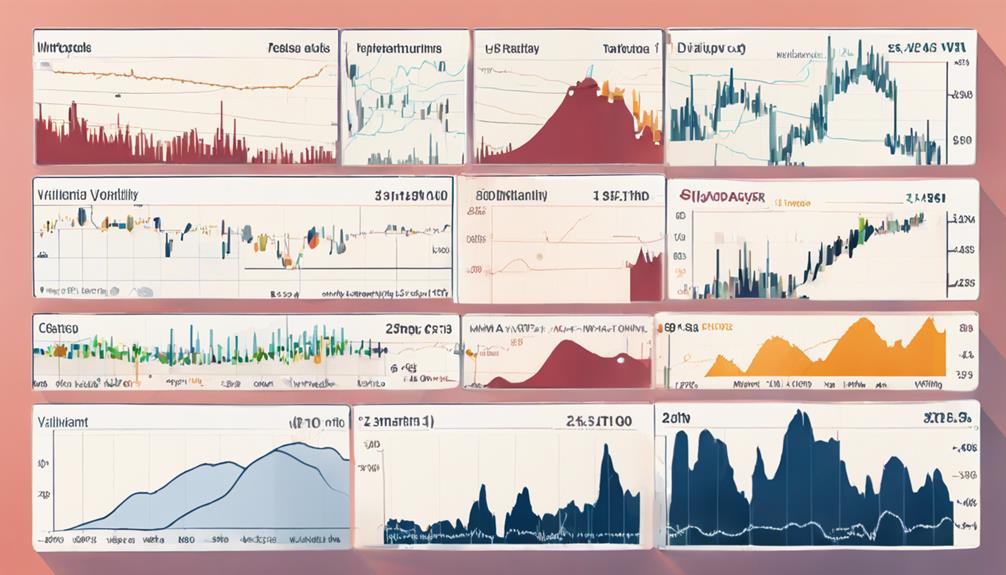
Analyzing VIX spikes and dips provides valuable insights into market volatility and potential shifts in investor sentiment.
By examining historical VIX trends, investors can better gauge the level of market stress and anticipate possible market movements.
Understanding the patterns within the VIX can offer a clearer picture of market dynamics and assist in making informed investment decisions.
VIX Spikes and Dips
Deciphering VIX spikes and dips reveals important insights into market dynamics, guiding strategic decision-making for astute traders. When analyzing VIX patterns, traders should consider the following key points:
- VIX spikes above 30 signal market stress and potential downturns.
- Dips in VIX below 15 may indicate market complacency and a potential bullish trend.
- Short-term VIX spikes followed by rapid declines reflect swift changes in market sentiment.
- Understanding the context surrounding VIX spikes and dips can help anticipate market movements.
- Consistent monitoring of VIX patterns provides valuable insights into market volatility and potential future price action.
Historical VIX Trends
Interpreting historical VIX trends offers valuable insights into market behavior and potential future movements. Historical data indicates that VIX levels above 30 often signify heightened market volatility, while an inverse relationship with stock market performance is observed, linking high VIX levels to market declines.
Prolonged periods of low VIX values have historically foreshadowed market corrections or downturns. Remarkably, in 2020, the VIX surged to an unprecedented level exceeding 80 amidst the COVID-19 pandemic-induced market turmoil.
Identifying Key VIX Levels
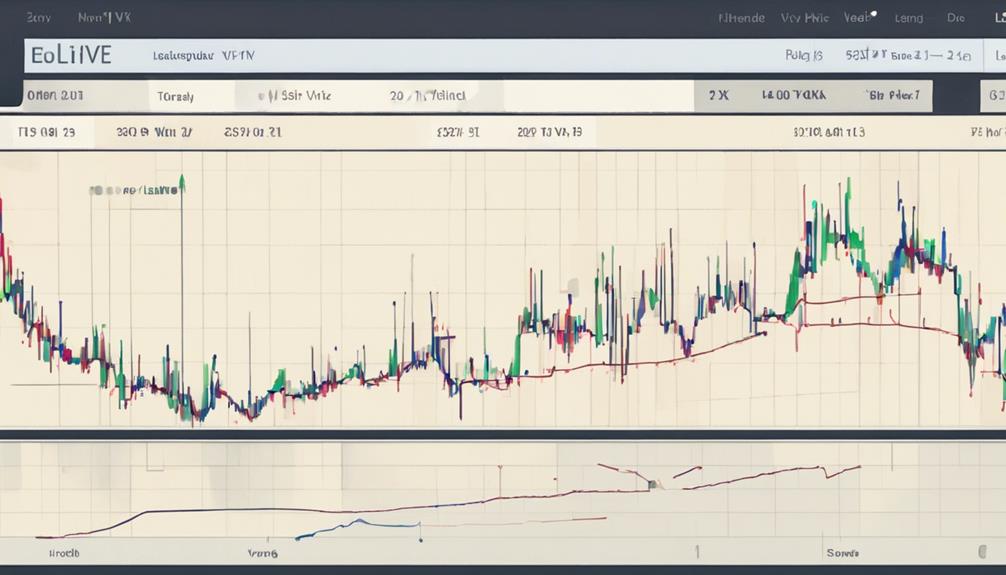
Identifying the key VIX levels provides traders with essential insights into market stability and potential volatility. When the VIX falls, traders should pay attention to specific levels to gauge market sentiment and potential shifts.
Here are five key VIX levels to keep in mind:
- VIX at 20: Indicates relative market stability, suggesting a relatively calm market environment.
- VIX at 30: Signals increased market volatility, indicating growing uncertainty among investors.
- VIX above 40: Typically reflects high levels of fear and uncertainty in the market, potentially signaling extreme bearish sentiment.
- VIX below 15: Suggests low market stress and a potential bullish outlook, indicating a more optimistic market sentiment.
- Watching for historical highs: Traders often monitor VIX levels approaching or surpassing historical highs as these points may indicate potential market reversals.
Understanding these key VIX levels allows traders to make informed decisions based on the prevailing market conditions and the associated risks.
Recognizing Shifts in Volatility
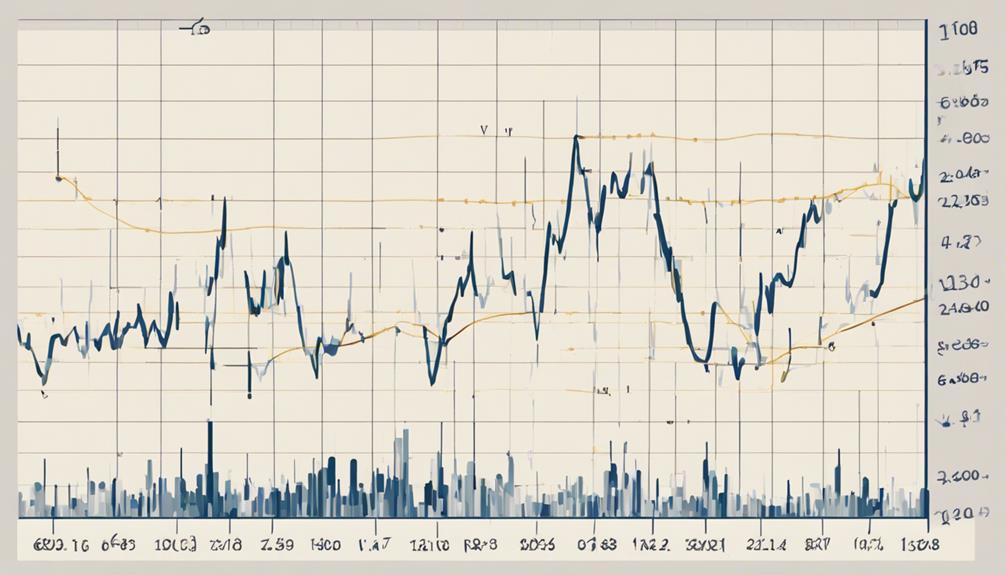
How can shifts in market volatility be effectively recognized and leveraged for informed decision-making strategies?
The Cboe Volatility Index (VIX) plays an important role in this process by tracking the implied volatility of S&P 500 index options. As shifts occur in the VIX, they indicate potential changes in market sentiment and risk levels. Understanding these movements is vital for predicting market corrections and trends.
High VIX values typically reflect increased market uncertainty and fear among investors, signaling a more volatile market environment. By monitoring VIX levels closely, traders and investors can adjust their trading strategies and risk management techniques accordingly. Recognizing these shifts in volatility can provide valuable insights into market dynamics, helping individuals make more informed decisions in response to changing conditions.
Therefore, staying attuned to fluctuations in the Cboe Volatility Index is a key aspect of mastering market predictions and navigating the complexities of stock market volatility.
VIX and Market Corrections
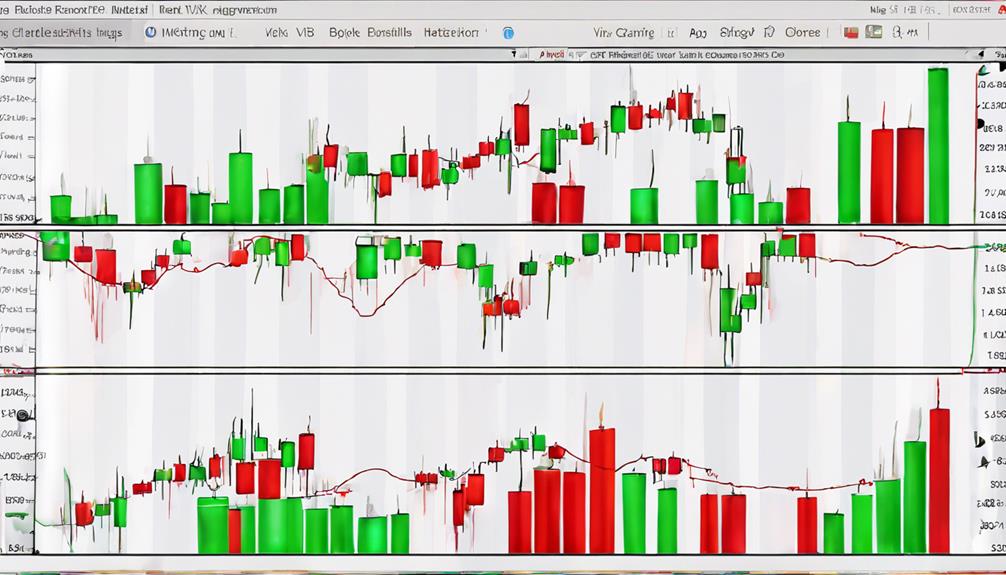
Shifting focus to VIX's role in market corrections reveals the significance of monitoring volatility levels for anticipating potential market shifts accurately. Understanding the VIX dynamics can provide valuable insights into the timing and extent of market corrections. Here are key points to ponder:
- VIX levels around 15 often signal an impending market correction, serving as an important threshold for investors.
- Analyzing VIX data can enhance the accuracy of predicting market corrections, offering a proactive approach to portfolio management.
- Monitoring VIX movements allows for estimating the expected duration of market corrections, aiding in strategic decision-making.
- Critical levels in VIX, like surpassing 18, are pivotal in indicating market corrections, guiding investors on potential market trends.
- Regular revisions in VIX analysis are essential for making precise forecasts about market corrections, ensuring adaptability to changing market conditions.
Importance of Regular Analysis

Regular analysis of the VIX is a fundamental practice for investors seeking to grasp the nuances of market volatility dynamics. The VIX, as a measure of expected market volatility, plays a vital role in understanding market sentiment and potential price movements.
Monitoring changes in the VIX provides valuable insights into market trends, helping investors make informed decisions. Consistent analysis of the VIX allows for the identification of patterns and correlations between volatility levels and stock market behavior.
By tracking the VIX on a regular basis, investors can stay ahead of market shifts, anticipate potential corrections, and adjust their strategies accordingly. This proactive approach to analyzing the VIX not only enhances market predictions but also enables investors to react promptly to changing market conditions.
Ultimately, regular analysis of the VIX is paramount for mastering market predictions and navigating the complexities of stock market volatility.
Anticipating Market Movements
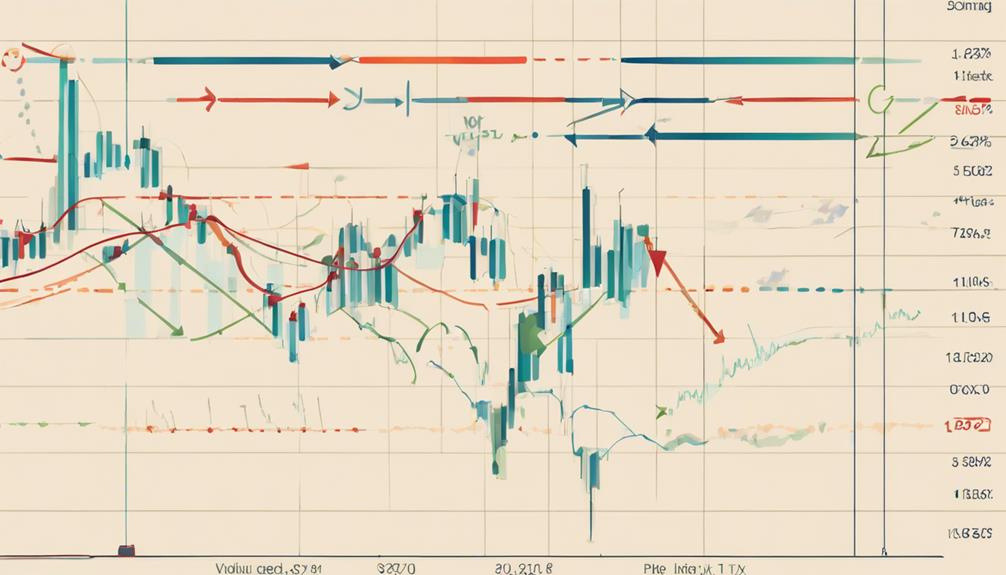
Effective anticipation of market movements is essential for investors looking to navigate the complexities of the financial landscape. The VIX, as a key indicator, plays an important role in helping investors anticipate market movements.
Here are five key points to keep in mind when using the VIX for market anticipation:
- VIX Tracks S&P 500 Expectations: The VIX monitors market expectations of S&P 500 changes, providing insights into potential market movements.
- Rising VIX Indicates Market Decline: Increasing VIX levels typically signal falling S&P 500 prices and a rise in SPX put options, indicating a bearish market sentiment.
- VIX Reflects Market Sentiment: High VIX values often correlate with market uncertainty or fear, while low VIX values signify lower levels of market stress.
- Complementary Analysis: Combining VIX analysis with technical and fundamental analysis can enhance the accuracy of predicting market reversals.
- Inverse Relationship with S&P 500: The inverse relationship between the VIX and S&P 500 makes the VIX an important tool for hedging and anticipating market movements.
Navigating Volatile Conditions

In volatile market conditions, traders must employ effective risk management strategies to protect their investments.
Interpreting the Volatility Index (VIX) accurately is essential as it provides insights into market sentiment and potential price movements.
Analyzing market trends alongside VIX fluctuations can help traders make informed decisions and adjust their strategies accordingly.
Risk Management Strategies
Managing volatile market conditions requires a strategic approach to risk management, with the VIX serving as a valuable tool in evaluating and adjusting equity exposure levels for effective portfolio protection. When maneuvering turbulent markets, consider the following risk management strategies:
- Utilize VIX as a primary risk indicator.
- Adjust equity exposure levels based on VIX readings.
- Monitor VIX movements for potential market corrections.
- Combine VIX analysis with technical and fundamental indicators.
- Implement VIX-based strategies to navigate volatile environments successfully.
Volatility Index Interpretation
Successfully maneuvering through volatile market conditions hinges on interpreting the Volatility Index (VIX) with precision and insight, offering a real-time gauge of market sentiment and risk levels.
The VIX, as a measure of expected S&P 500 volatility, indicates market stress and sentiment changes. A rising VIX often correlates with declining S&P 500 prices and a rise in SPX put options, signaling increased market uncertainty or fear.
Conversely, low VIX values suggest minimal market stress, potentially signaling bearish signals in trading strategies. Traders can utilize the VIX in conjunction with technical and fundamental analysis to gauge market volatility accurately.
Understanding VIX fluctuations can assist in making informed decisions, identifying potential market reversals, with high VIX indicating a buying opportunity and low VIX suggesting a bullish market outlook.
Market Trend Analysis
Getting through volatile market conditions requires a strategic and proactive approach to analyzing market trends effectively. When maneuvering volatility, consider the following key points:
- Utilize rising VIX values as an indication of potential falling S&P 500 prices and increasing SPX put options.
- High VIX levels reflect market uncertainty and investor fear, signaling a need for caution.
- Falling VIX values may suggest rising S&P 500 prices or a more stable market environment.
- Low VIX readings indicate minimal market stress, which could lead to bearish signals if not considered carefully.
- Enhance market trend predictions by combining VIX analysis with technical and fundamental analysis techniques.
Trading Strategies With the VIX
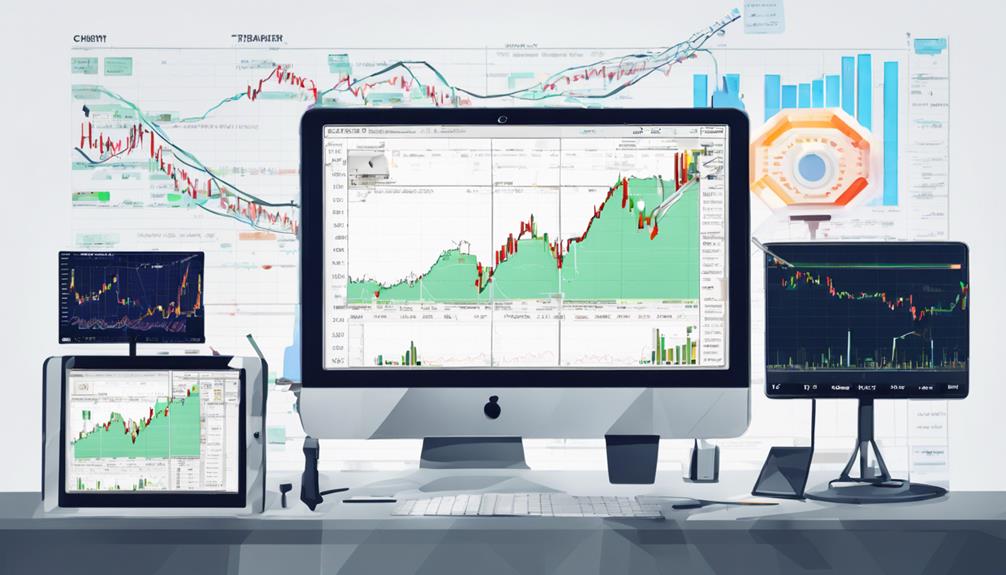
Utilizing the VIX as a key indicator, traders can develop effective strategies to navigate market fluctuations and capitalize on varying levels of volatility. The VIX, also known as the 'fear index,' is widely used by traders to gauge market sentiment and potential trends. A high VIX value typically indicates market uncertainty or fear, which can present buying opportunities for investors looking to capitalize on potential market upswings. Conversely, low VIX values suggest little market stress, signaling a bullish sentiment and potentially prompting traders to adjust their strategies accordingly.
Moreover, the VIX can serve as a valuable hedging tool, allowing traders to protect their portfolios against sudden market volatility. By combining VIX analysis with technical and fundamental analysis, traders can gain a more thorough understanding of market conditions and make informed trading decisions. Different VIX levels provide insights into market volatility, enabling traders to adjust risk management strategies to suit the prevailing market environment effectively.
Ultimately, incorporating the VIX into trading strategies can help traders better navigate market fluctuations and optimize their investment outcomes.
Leveraging VIX Data for Decisions

When interpreting VIX data for decision-making, traders can gain valuable insights into market sentiment and potential reversals based on real-time expectations of S&P 500 changes. Leveraging VIX data allows traders to make informed decisions by understanding market dynamics.
Here are five key ways traders can use VIX data effectively:
- Market Sentiment Analysis: VIX data provides a snapshot of market sentiment, indicating the level of fear or complacency among traders.
- Volatility Forecasting: Traders can anticipate potential market volatility by monitoring VIX trends, helping them adjust their strategies accordingly.
- Risk Management: VIX data aids in evaluating market risk, enabling traders to implement risk mitigation strategies to protect their portfolios.
- Timing Market Entries: By analyzing VIX data, traders can identify strategic entry points into the market based on volatility levels.
- Contrarian Indicators: Extreme VIX values can signal potential market reversals, guiding traders to explore contrarian trading strategies for profit opportunities.
VIX as a Market Indicator

The VIX serves as a critical market indicator providing insights into market sentiment and volatility expectations. Understanding the VIX basics, interpreting trends, and utilizing VIX data for trading decisions are essential components of leveraging this indicator effectively.
VIX Basics Explained
Introduced in 1993 by the Chicago Board of Options Exchange, the VIX serves as an important market indicator by tracking real-time market expectations of S&P 500 changes. The VIX, also known as the 'fear gauge,' is a vital tool for investors to gauge market sentiment and risk levels.
Here are five key points to understand the basics of the VIX:
- The VIX measures market stress and risk based on at-the-money SPX options.
- It calculates volatility expectations using both standard and weekly SPX options.
- Rising VIX values are often associated with falling S&P 500 prices and increased SPX put options.
- Low VIX levels indicate minimal market stress and potential bearish signals.
- The VIX provides valuable insights into market uncertainty and fear levels, aiding investors in making informed decisions.
Interpreting VIX Trends
Utilizing VIX trends as a pivotal market indicator allows investors to gauge volatility expectations and anticipate potential market shifts with precision and insight. The VIX, also known as the 'fear index,' rises when there is an expected increase in market volatility, often resulting in a decline in S&P 500 prices.
High VIX values signal market uncertainty and fear among investors, indicating a potential bearish market sentiment. Conversely, falling VIX levels are associated with rising S&P 500 prices or market stability. Low VIX values suggest minimal market stress, potentially leading to bullish signals.
Understanding and interpreting VIX trends is essential for traders looking to navigate market fluctuations and position themselves strategically based on volatility expectations.
Using VIX for Trading
Interpreting VIX trends can greatly enhance trading strategies by leveraging the VIX as a reliable market indicator for anticipating potential market shifts and volatility expectations. When using VIX for trading and market timing, consider the following:
- VIX as a real-time index for tracking S&P 500 changes.
- Rising VIX values indicating market uncertainty or fear, potentially leading to falling S&P 500 prices.
- Low VIX levels suggesting little market stress, leading to bearish signals and decreased volatility.
- Combining VIX analysis with technical and fundamental analysis can enhance trading strategies.
- The inverse relationship between VIX and S&P 500 makes VIX a popular tool for hedging against market volatility and timing market entries and exits.
Incorporating VIX in Trading Plans

Incorporating the VIX into trading plans provides valuable insights for identifying potential market reversals and confirming trends. Traders can utilize the VIX not only as a tool to predict market movements but also as a means of hedging against market volatility and adjusting risk management strategies.
By combining VIX analysis with technical and fundamental analysis, traders can make more informed decisions. VIX signals can be instrumental in timing market entries and exits, monitoring market sentiment, and confirming trend reversals. The levels of the VIX can indicate market stress, fear, or stability, thereby influencing trading strategies accordingly.
Integrating the VIX into trading plans offers a holistic approach to maneuvering the dynamic landscape of the stock market. By understanding the implications of VIX movements, traders can adapt their strategies to capitalize on potential opportunities while mitigating risks associated with market fluctuations.
VIX and Stock Performance

The relationship between the CBOE Volatility Index (VIX) and stock performance is a key factor influencing investment strategies and risk management decisions in the financial markets. When considering the VIX and stock performance, several essential points emerge:
- Stocks tend to perform better when volatility, as measured by the VIX, is low.
- A study by Moreira and Muir suggests higher equity exposure during low volatility periods.
- The CBOE Volatility Index (VIX) currently sits 20% below its historical average.
- Adjusting equity exposure based on VIX levels can enhance risk-adjusted performance.
- Choosing a middle-of-the-road VIX level can help determine target equity allocation.
These insights highlight the significance of monitoring the VIX in conjunction with stock performance to inform investment decisions effectively. By understanding how the VIX impacts stock behavior, investors can adjust their strategies to capitalize on market conditions and optimize portfolio performance.
Mastering Market Predictions

Understanding the fundamentals of the VIX and analyzing market trends are key components in mastering market predictions.
By delving into VIX basics and interpreting its movements alongside market behavior, investors can gain valuable insights into potential market shifts.
This analytical approach can greatly enhance decision-making processes and improve overall prediction accuracy.
VIX Basics Explained
When delving into the domain of market predictions, a fundamental concept to grasp is the explanation of VIX basics, essential for understanding market volatility dynamics. The VIX, also known as the 'fear gauge,' is a real-time index that tracks market expectations of S&P 500 changes. It represents the price traders are willing to buy/sell the S&P 500 for the next month based on at-the-money SPX options. Introduced in 1993 by the Chicago Board Options Exchange, the VIX involves complex calculations using put and call options values to calculate market volatility. Interpreting VIX levels can provide insights into market volatility expectations, aiding traders in making informed decisions.
- Real-time index tracking S&P 500 changes
- Introduced by the Chicago Board Options Exchange
- Represents future S&P 500 price based on at-the-money SPX options
- Calculated using put and call options values
- Provides insights into market volatility expectations
Market Trends Analysis
In mastering market predictions, a thorough analysis of market trends is essential for informed decision-making and strategic trading. Analyzing the VIX movements plays a crucial role in predicting market trends accurately. The VIX, as a key indicator of stock market volatility and potential reversals, provides valuable insights for traders. Understanding the levels of the VIX is paramount in mastering market predictions and making well-informed trading decisions. By utilizing VIX data, investors can adjust their risk management strategies based on market sentiment, thereby enhancing their ability to forecast market trends effectively. Combining VIX analysis with other indicators further strengthens the accuracy of market trend predictions.
| Aspect | Importance | Impact |
|---|---|---|
| VIX Movements | High | Predictive accuracy |
| Market Volatility | Significant | Reversal identification |
| Risk Management | Essential | Informed decisions |
Frequently Asked Questions
How to Predict Market With Vix?
To predict the market with VIX, traders can employ various VIX strategies. By monitoring VIX levels in conjunction with market trends and indicators, traders can gauge market sentiment and potential reversals.
High VIX readings often indicate increased market volatility and uncertainty, while low VIX values suggest a calmer market environment. Integrating VIX analysis into a comprehensive trading strategy can provide valuable insights for making informed decisions about market movements and potential opportunities.
How to Use VIX as an Indicator?
Utilize various VIX strategies by closely monitoring this volatility index alongside market trends for enhanced trading decisions.
Incorporate VIX analysis with technical and fundamental indicators to gain a thorough view of market conditions.
Employing VIX as an indicator involves interpreting its levels in conjunction with historical patterns to gauge market sentiment and potential price movements.
Integrating VIX insights into trading strategies can provide valuable perspectives for managing volatile market conditions effectively.
What Is the Rule of 16 in Vix?
The Rule of 16 in VIX is a calculation method used to estimate annualized volatility in the S&P 500 based on the VIX index reading. By multiplying the VIX value by 16, traders and investors can quickly determine the expected level of market volatility.
For instance, a VIX reading of 20 would suggest an anticipated annualized volatility of approximately 320 (20 x 16). This rule serves as a valuable tool for interpreting implied volatility levels derived from the VIX.
Is VIX a Good Measure of Volatility?
The VIX serves as a useful measure of volatility due to its ability to gauge market expectations of future price fluctuations. While it may not perfectly predict actual volatility levels, the VIX accuracy in reflecting investor sentiment and risk perception is generally reliable.
Traders often rely on the VIX as a valuable tool for evaluating market conditions and making informed decisions regarding market entries, exits, and risk management strategies.
Conclusion
To sum up, mastering market predictions with the VIX index requires a deep understanding of stock volatility patterns and key levels. By identifying shifts in volatility and incorporating VIX in trading plans, investors can better navigate market corrections and anticipate stock performance.
The VIX serves as a valuable market indicator, providing insights into market sentiment and potential future movements. To stay ahead of the curve, investors must utilize the VIX as a powerful tool in their investment strategies.
Remember, knowledge is power.
